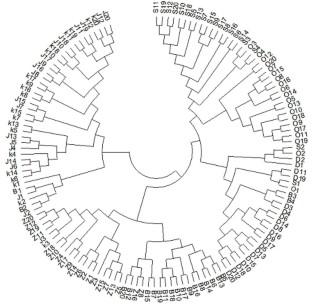Molecular Biology Reports ( IF 2.8 ) Pub Date : 2024-04-20 , DOI: 10.1007/s11033-024-09473-x Imen Ben Elhadj Ali , Islem Yangui , Anhar Raadani , Arbi Guetat , Soumaya Hmissi , Jihène Flihi , Mohamed Boussaid , Chokri Messaoud

|
Background
Thymus algeriensis Boiss. et Reut. is one of the most widespread North African species of the genus Thymus L. The species is subshrub growing primarily in subtropical biome of Morocco, Algeria, Tunisia and Libya. In Tunisia, the plant species is under high pressure of anthropogenic activities including over-collecting. The assessment of genetic diversity and population structure of T. algeriensis is a pioneer step to retrace its evolutionary history and to perform appropriate conservation strategies of the plant species.
Methods and results
Seven wild populations growing, widely, in different bioclimatic zones were selected and analysed using two molecular markers systems. Fifteen Simple Sequence Repeats (SSRs) and fifteen Inter-Simple Sequence Repeats (ISSRs) were used to characterize genetically 140 different genotypes. The results showed a high molecular variation within populations and among the studied genotypes. The intra-populations genetic diversity revealed by SSRs was higher (P = 80.95%, Na = 2.143 and He = 0.364) than that based on ISSRs (P = 78.12%, Na = 1.632, He = 0.265 and I = 0.398). As demonstrated by inbreeding coefficients, a significant level of differentiation and a low level of gene flow were detected among studied populations (FST = 0.161 for SSRs and ΦST = 0.197 for ISSRs). Furthermore, the results of ISSRs marker suggest land strips as barriers in population genetic structure. While SSRs marker reflects a relatively structured bioclimatic patterns of studied populations. The Bayesian analysis showed a specific adaptation of populations to local environments.
Conclusions
The used molecular markers (ISSRs and SSRs) seem to be effective in deciphering genetic polymorphism of Tunisian genotypes of T. algeriensis. Therefore, the genetic structure of the studied genotypes could constitute a starting point for further conservation, characterization and breeding programs.
中文翻译:

阿尔及利亚百里香 Boiss。 et Reut.,一种北非特有植物物种:通过分子标记评估遗传多样性和种群结构,这是保护意义的先驱一步
背景
阿尔及利亚百里香Boiss。等路透。是北非最广泛分布的百里香属物种之一。该物种是亚灌木,主要生长在摩洛哥、阿尔及利亚、突尼斯和利比亚的亚热带生物群落中。在突尼斯,植物物种面临着包括过度采集在内的人类活动的高压。对阿尔及利亚红木耳遗传多样性和种群结构的评估是追溯其进化历史并对该植物物种实施适当保护策略的先驱一步。
方法和结果
使用两种分子标记系统选择并分析了在不同生物气候区广泛生长的七个野生种群。使用 15 个简单序列重复 (SSR) 和 15 个简单序列重复之间 (ISSR) 来表征 140 种不同基因型的遗传特征。结果显示群体内和所研究的基因型之间存在高度的分子变异。 SSR揭示的群体内遗传多样性(P = 80.95%,Na = 2.143和He = 0.364)高于ISSR(P = 78.12%,Na = 1.632,He = 0.265和I = 0.398)。近交系数表明,在研究群体中检测到显着水平的分化和低水平的基因流(SSR 的 F ST = 0.161, ISSR 的Φ ST = 0.197)。此外,ISSR 标记的结果表明,土地带是种群遗传结构的障碍。而 SSR 标记反映了研究人群相对结构化的生物气候模式。贝叶斯分析显示人口对当地环境的特定适应。
结论
所使用的分子标记(ISSR 和 SSR)似乎可以有效破译阿尔及利亚突尼斯基因型的遗传多态性。因此,所研究的基因型的遗传结构可以构成进一步保护、表征和育种计划的起点。



























 京公网安备 11010802027423号
京公网安备 11010802027423号